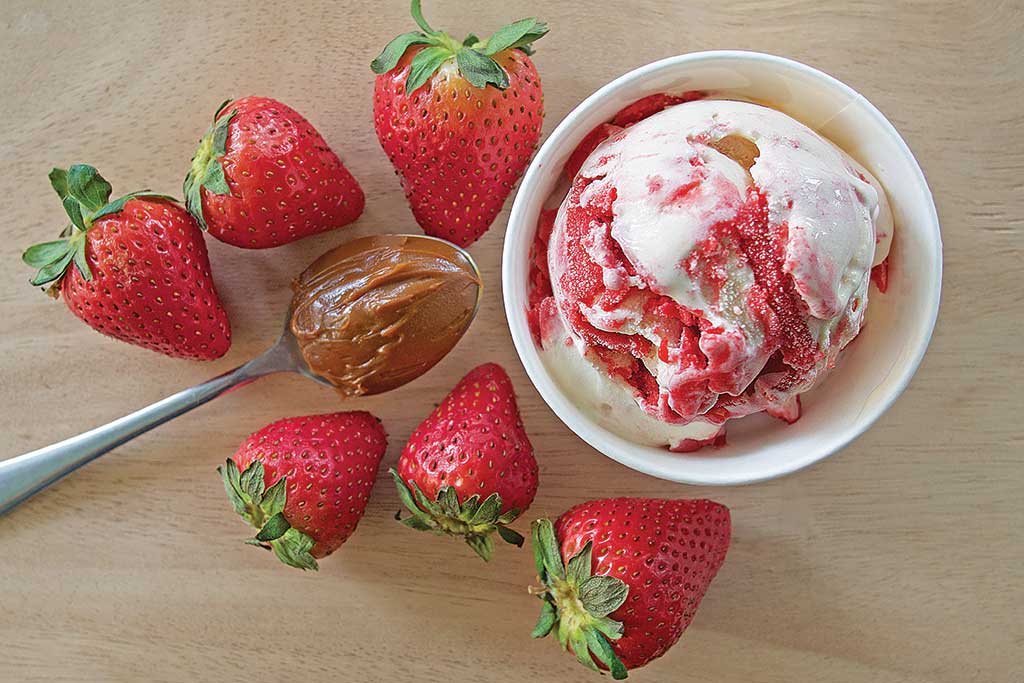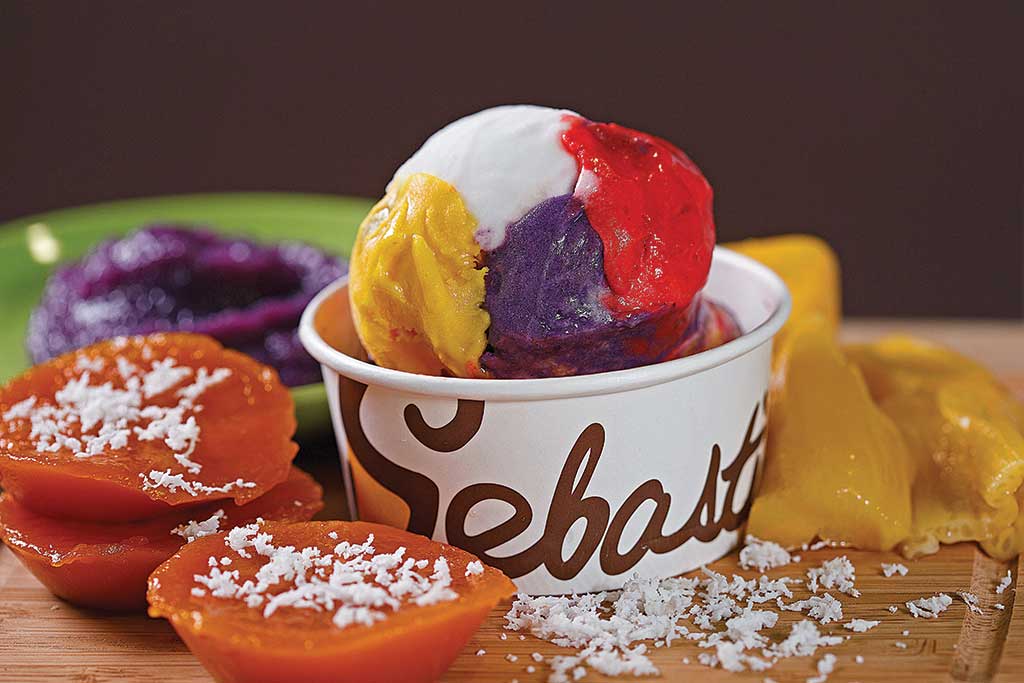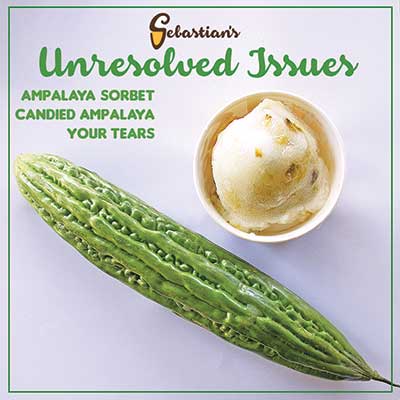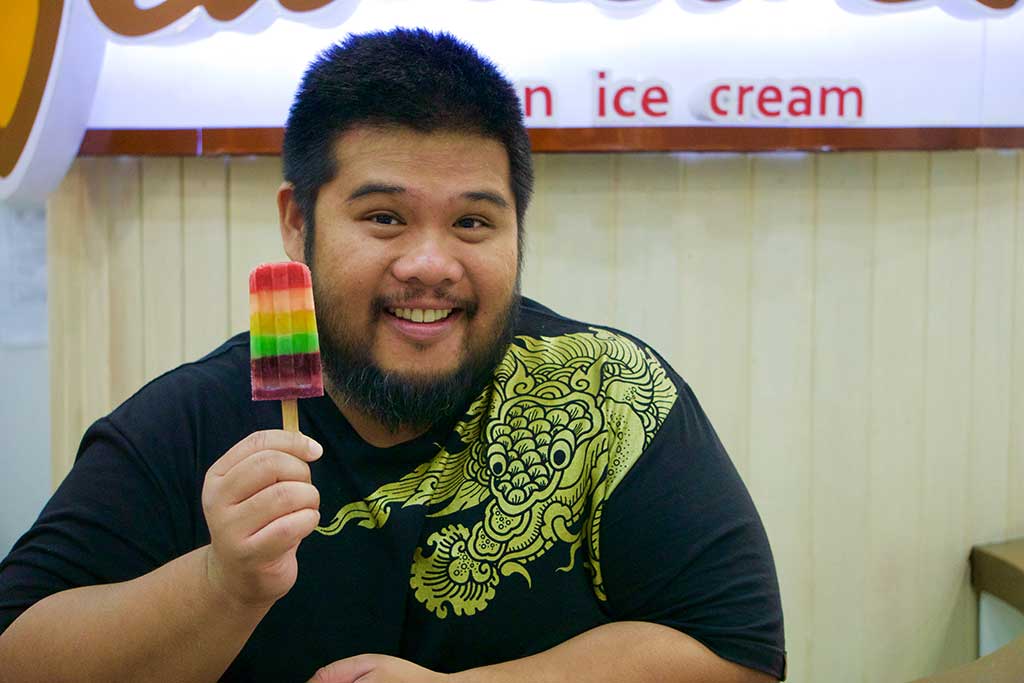New York’s world-famous Big Gay Ice Cream may need to hand over their title to the Philippines’ Ian Carandang. The openly gay, Manila- based sorbetero is founder of Sebastian’s Artisan Ice Cream (www.facebook.com/sebastians.ice.cream), which not only pushes the envelope with adventurous “big” flavors, but also unabashedly gay, frosty items like rainbow and bear-pride flag colored ice pops, and a wonderfully cute, decadent chocolate-enrobed Chubby Bar line featuring some of Manila’s cutest bears and cubs in its cheeky ad campaign.
“It was hugely successful,” Carandang admits, “and they sold quickly despite being a [higher-priced] item. As for the models, all of whom are my friends, they’re now local ‘bear-lebrities.’ I asked them to make an appearance at this year’s Pride to sell ice cream at our stall, and they were absolutely mobbed. I’m told that they still regularly get asked on Growlr if they’re the ones from the ads. The campaign set a new benchmark for product launches, filled with good vibes and positivity, and I’m looking to make that a cornerstone of the Sebastian’s product cycle.”

Carandang himself is proudly chubby, gregarious, opinionated, and a passionate advocate for his nation’s culinary traditions and offerings. To that end, he’s bringing more Philippine flavors, ingredients, and dishes, both savory and sweet, to Sebastian’s delicious product line, which includes 15 scoopable flavors at any given time, colorful 30-layer ice pops (paletas), Chilly Burger ice cream cookie sandwiches, Chubby Bars, and frozen cheesecake bars.
Sebastian’s Chocolate-Covered Chicharrón ice cream incorporates crunchy fried pork rinds, a ubiquitous Filipino snack, in much the way Portland’s Salt & Straw, Brooklyn’s Oddfellows, and other creative USA ice cream makers have integrated bacon. Iconic dessert halo-halo is presented as colorful 30-layer paletas, which take three days to craft. Components include jackfruit, coconut-based jelly nata de coco, sugar palm fruit, glutinous rice pinipig, and beans. Sapin Sapin, a multi-layered, gelatinous confection fashioned from violet-hued Ube yams and coconut, becomes an ice cream delight also made up of several distinct, multi-hued flavors. Chocolate rice pudding dish Champorado is deliciously rendered as ice cream, although an optional candied dilis (anchovies) topping takes it to the next über-local, funky level.
“I am definitely looking more inward for local flavors,” Carandang shares, “as my next crop of ice creams are all based on local desserts and confections.”
How about balut, the infamous Filipino street and bar snack (a duck egg with partially formed embryo) that sends most Western visitors and even some locals into gagging mode?
“Never say never,” Carandang grins in response. “Once I crossed the Rubicon with Green Mango Sorbet and bagoong, a fermented shrimp paste, nothing is off limits at this point. What I wouldn’t do, though, is make a flavor just for shock value. Even though some flavors, like Bitter Melon Sorbet, called Unresolved Issues and released every Valentine’s Day for ironic purposes, grab a lot of media coverage for their ‘WTF!?’ factor, I approach every flavor, whether mundane or radically experimental, by making it as delicious as possible and faithful to the source inspiration.”
Iget to sample many of the above flavors and products at Sebastian’s location on the fourth floor of The Podium shopping center, located in Mandaluyong, one of 16 cities that make up Metro Manila. I first met Carandang, however, at the Shangri-La Makati, conveniently posited in one of the traffic-plagued metropolis’ most boutique-y, walkable districts, with upscale shopping developments, craft coffee shops, greenery, and a proliferation of excellent new dining spots and hipster denizens.
Over the next few days, Carandang thoroughly schools me on Filipino cuisine, its history, its most exciting new chefs, and, of course, Sebastian’s and his career as the country’s sole openly gay sorbetero.

Sebastian’s Matinong Boyfriend Ice Cream
“In terms of the culinary scene, quite a few openly gay Filipino chefs have made their mark,” he notes. “The late Ed Quimson was very much a mentor to a whole generation of chefs [and I use his bagoong recipe in my Green Mango sorbet]. Chef Miko Aspiras is one of the most widely acclaimed pastry chefs in the country, and local press has done features about him and his fiancé, JV San Juan, which is amazing. LGBT rights in the Philippines is a work in progress, and same-sex marriage is still considered a pipe dream at this point even by the staunchest supporters. Not surprising, considering we are the last country on the planet without divorce. But in the culinary scene at least, being gay is definitely not an issue.”
Born in Makati City and raised in Metro Manila, Carandang a first found inspiration for his career thanks to Ben & Jerry’s. As a youth during the early 2000s, he was only able to access the Vermont-based pair’s 1987 recipe book, as the product itself wasn’t available locally. However, thanks to a stroke of luck and frozen stock at a duty-free shop, he finally sampled chunky monkey, Wavy Gravy, cookie dough, and other flavors. “It was like an atomic bomb went off in my head,” he recalls, “and my perspective on ice cream was blown to smithereens. For someone who up until that point had only been familiar with vanilla, Rocky Road, strawberry and ube, I resolved there and then to make my own Ben & Jerry–style ice cream for myself. And that’s where the seeds of Sebastian’s were planted.”
Come 2006, after teaming up with college pals and a year of exclusively marketing to restaurants, Sebastian’s opened a first retail “scooping station” stall in an Alabang mall. Today there are three locations in Metro Manila, and pop-up booths at events including Manila’s Gay Pride.
It was one such pride showing that ultimately led to Carandang’s public coming out. “For one day we renamed all of our flavors with drag names,” he recalls. “Cookie Dough became ‘Cookie Dontcha Wish Your Boyfriend Was Hot Like Me,’ and Salted butter caramel became ‘Senyorita Saltina Buteraka Carmela.’ It had a great reception, but there was one comment on Facebook that said in Tagalog, ‘a faggot must have done this.’ I deleted it and blocked the user, and then I made this short, heartfelt post coming out publicly, talking about who I was and that bigotry and intolerance of this kind would have no place on our wall. It was an emotionally driven decision, admittedly not the most professional move, but Sebastian’s itself is very personal to me. Thankfully, there was no blowback as far as I could tell and the post itself had nothing but positive support and encouragement. “

Sebastian’s Sapin Sapin Ice Cream
Besides his rainbow-colored gay pride ice bar, Carandang also crafts a bear-pride flag bar with scrump- tious and creamy layers of Nutella, peanut butter, caramel, coffee, black sesame, and bittersweet chocolate sorbets. 2016 saw the introduction of the bear-y yummy and artery-clogging Chubby Bars (Chocolate Chip Fudge, with chocolate chip cookie, vanilla ice cream, ganache, and a milk chocolate coating). It’s no surprise that Carandang is a prominent member of the Manila bear community, and at one dinner he introduces me to a friend, Kookie, who heads up a cute ursine T-shirt line called Monster Bear Wear Manila (www.facebook.com/monster-bear-wear-manila-617012085042395).
“Although not as active as in other countries, bear communities do exist here,” Carandang says. “The largest one would be BiggerManila, which arranges annual events MyChuva in February and ChubiBoo in October, where the whole bear community gets together in one place to meet people they usually only see online. There’s currently no official bear bar in Manila, but the closest thing would be Sunstar karaoke bar in Cubao, also sometimes referred to by it’s original name, Satellite. It’s a seedy, smoky joint where blue-collar gays hang out to drink, sing, and mingle late into the night. You get to see gruff laborer types belting out Celine Dion songs, which is admittedly an experience.”
On a more generalized level, Carandang characterizes the Manila gay scene as one where LGBTs are acknowledged and recognized. Sassy young gay boys slinging Vuitton bags and rocking skintight jeans are a common sight around Makati’s Greenbelt shopping development, yet bigots can still fire off homophonic comments publicly with little repercussion.
“There’s this unspoken attitude of, ‘you can get this amount of rights, but this is as far as it goes.’ The Roman Catholic Church still has a stranglehold over the majority of the population, and gay Catholics struggle to reconcile being part of an institution that openly discriminates against them. It’s more of tolerance than genuine equality. That being said, if you want to meet some gay locals, all you have to do is turn on your Growlr or Grindr in Manila and watch the greetings pile up. Just be wary of hustlers and scam artists!”
One day, Carandang brings me to one of his favorite places to cool off, the Ace Water Spa, an indoor water-park-meets-health-spa beloved by Filipinos of all ages. Some other favorite local spots he introduces me to include Little Tokyo and Chinatown, the five-floor Fully Booked bookstore in upscale, leafy BGC district, and weekend markets Salcedo (Saturdays) and Legazpi Park (Sundays).

“I love Manila in that first and foremost it was where I was born and the place I grew up in,” he tells me. “It’s taken care of me and even though it can make itself hard to love at times, I want to give back to it. This city, much like the country itself, has been through a lot. Four hundred years of colonization by the Spanish, 40 under the Americans, two under the Japanese. Celebrated as the Pearl of Asia at the beginning of the 20th century, to being pitied as the Sick Man of the region in the 1980s. It is very imperfect. But at the same time, it’s a city with soul. Manila has a fire borne from adversity, a thirst for recognition, and a hunger for greatness. It’s dysfunctional in exactly the way a place needs to be to become a hotbed for amazing work in music, food, theater, art, and life. Yet most of all, I love that Manila in the last five years has truly become this exciting foodie hub. A stronger economy with more purchasing power, combined with a globally aware populace who know about the trends going on internationally and are hungry to try them out, have resulted in a vibrant restaurant scene.”
Regarding his favorite places to travel, for food or otherwise, Carandang numerates beauteous Philippine island Palawan, Japan’s Tokyo, Kyoto, Osaka, and Hokkaido, the latter for its world-class soft serve and dairy product (a hotly desired premium within Asia), the USA’s San Francisco (an artisanal ice cream mecca thanks to innovators Bi-Rite Creamery and Humphry Slocombe), NYC, and Dallas, Texas.
In fact, a few days after we parted ways, Carandang headed to Dallas for the annual Texas Bear Round-Up, aka TBRU.
“I’d like to someday attend other bear events,” he enthused. “Provincetown Bear Week, Sonoma California’s Lazy Bear Weekend, Orlando’s Tidal Wave, and Chicago’s Bear Pride. Attending my first ever bear event really changed my life, showing me a world of inclusivity, body positivity, and ultimately led to meeting my amazing boyfriend, Kameron. Of course, I need to go to Vermont and visit the Ben & Jerry’s plant there. It’s basically my pilgrimage to mecca to pay homage to my ice cream sensei.”


